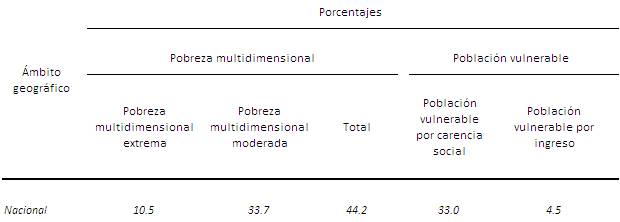1. What is Multidimensional Poverty?
Situation a person is in when the exercise of at least one of his/her rights for social development is not guaranteed, and his/her income is insufficient to acquire the goods and services he/she requires to satisfy his/her needs.
2. Which are the dimensions and indicators used in multidimensional poverty measurement?
 Educational Gap
Educational Gap Population age 3 to 15
Population age 16 or older born by 1981
Population age 16 or older born as of 1982
 Access to Health Services
Access to Health Services
Population affiliated to Seguro Popular
Population affiliated to IMSS
Population affiliated to ISSSTE or state ISSSTE
Population affiliated to PEMEX, Defense or Marine
Population affiliated to other institutions
 Access to social security
Access to social security
Employed population without access to social security Economically inactive population without access to social security
Population age 65 and older without access to social security
 Quality and Spaces of the Dwelling
Quality and Spaces of the Dwelling
Population in homes with floor material below threshold
Population in homes with roofing material below threshold
Population in homes with wall material below threshold
Population in overcrowded homes
 Access to Household Services
Access to Household Services
Population in homes with access to water below threshold
Population in homes with sewage below threshold
Population in homes with electricity below threshold
 Access to Food
Access to Food
Food security
Slight level of food insecurity
Moderate level of food insecurity
Severe level of food insecurity
3. How are multidimensional poverty wellbeing lines defined?
Wellbeing line: Wellbeing line: monetary value of a food and non-food basket of basic consumption.
Minimun wellbeing: its the monetary value of a basic food basket in a particular month. For purposes of poverty measure, the reference value of the basket is the month of August of the year when the measurement is held. This line is calculated for rural and urban areas.
4. What are the values of the wellbeing lines of multidimensional poverty?

5. What’s the difference between the INEGI-CEPAL basket and that elaborated by CONEVAL?
The basket elaborated by CEPAL in 1992 makes estimations with information from the 1984 National Survey of Income and Expenditure at Households (ENIGH). The basket elaborated by CONEVAL is based on the methodological proposal by the Economic Commission for Latin America and the Caribbean (CEPAL), which takes as a reference home expenditure patterns to approach the energy and micronutrient intake according to different income levels.

View larger image

View larger image
6. How many people are in multidimensional poverty and how many are vulnerable in 2008?

View larger image
7. How is income poverty calculated?
The estimation of income poverty uses as a source the National Household Income and Expense Survey (ENIGH). The latest available survey is the 2010 ENIGH. From this survey the distribution of net income per capita is constructed. Finally, said distribution is compared with the poverty line updated for that year and identifies as poor those who are under the line.
8. Which are the income poverty line values for the latest available estimation?

9. How is the Social Gap Index constructed?
The social gap index is constructed through the principal components analysis (PCA) statistical technique. Said technique analyzes the indicator variation to create weights for each of its components. This allows classifying and summarizing different dimensions into a single indicator.
10. How is the Social Gap Index stratified?
Stratification takes place through the Danelius and Hodges method. This method groups federal entities, municipalities or similar localities within a particular group with the condition that this group is different from the other.